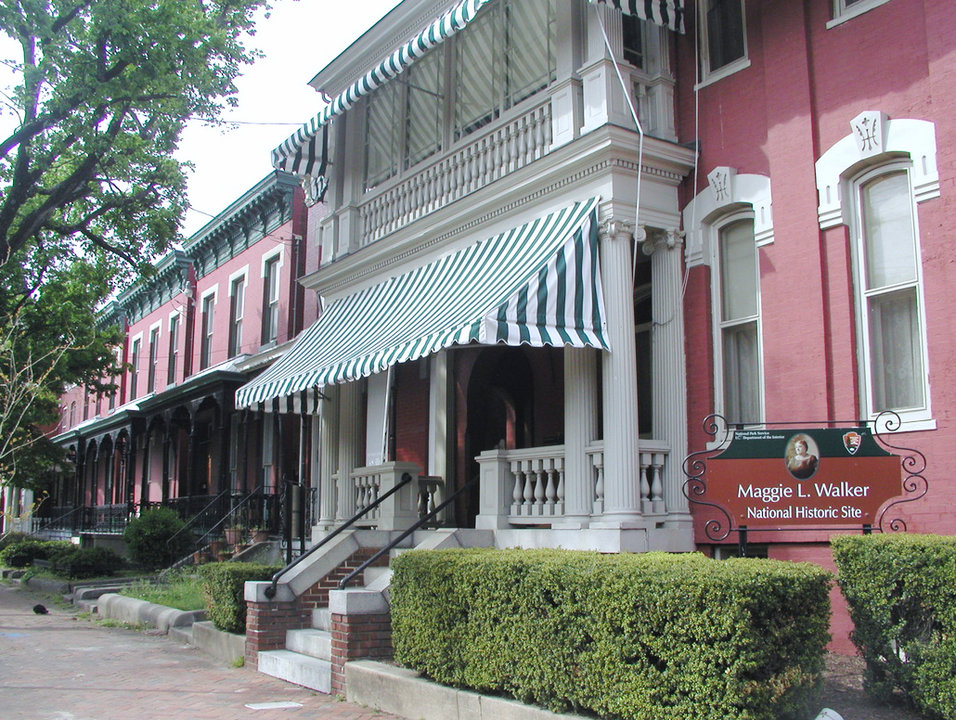The Maggie L. Walker National Historic Site is a United States National Historic Landmark and a National Historic Site Richmond, Virginia. The site was designated a U.S. National Historic Landmark in 1975. The National Historic Site was established in 1978 to tell the story of the life and work of Maggie L. Walker (1867-1934), the first woman to serve as president of a bank in the United States. It was built by George W. Boyd, father of physician, Sarah Garland Boyd Jones. The historic site protects the restored and originally furnished home of Walker. Tours of the home are offered by National Park Service rangers.
Maggie Walker, the daughter of a slave, was a pioneering African-American businesswoman and civil rights activist. She was an influential member of the NAACP, and is credited with found the first African-American female-owned bank, St. Luke’s Penny Bank (long since folded by mergers into other institutions), in 1902. She was also involved in local philanthropic efforts, supporting schools for education African-American girls in Richmond.
The Maggie L. Walker National Historic Site preserves the home, belongings, and legacy of pioneering civil rights activist, Maggie Lena Walker. Born to a former slave in the capital of the Confederacy during the final year of the Civil War, Maggie Walker rose to notoriety during the height of the Jim Crow era. From her headquarters in Richmond, Walker commanded an African American fraternal organization called the Independent Order of St. Luke (IOSL). In her capacity as Right Worthy Grand Secretary, Maggie Walker not only built the ranks of the IOSL to over 100,000 members in 24 states, but she used her organization as an engine of economic uplift, race pride, and gender advancement. She ran a bustling headquarters office, launched a newspaper, opened a department store, and in 1903, established the St. Luke Penny Savings Bank making Walker the nation’s first African American female bank president. In addition to her fraternal and business responsibilities, Maggie Walker lent her leadership to a growing number of local and national civil rights activist groups. She spent her life campaigning to improve the lives of African American men, women, and children.
The Maggie Walker NHS is located north of downtown Richmond, in the city’s historically black Jackson Ward neighborhood. It consists of six buildings on the north side of East Leigh Street, including 110 A E. Leigh Street, 112 E. Leigh Street, 114 East Leigh Street, 600 North 2nd Street, and 602 North 2nd Street.[5] Most of these buildings have exteriors reflective of the early 20th century, with their interiors repurposed to house Park Service facilities, including a museum and visitor’s center, as well as curatorial spaces.
The centerpiece of the site is the Maggie Walker House, a two-story Victorian Gothic brick rowhouse located near the center of the block of East Leigh between 1st and 2nd Streets. A Colonial Revival porch with sunroom above covers the front of the house. The interior is furnished with original belongings of Maggie Lena Walker, and period furnishings dating to the 1920s and 1930s. The house, complete with Walker’s effects, were donated to the people of the United States by her descendants in 1979.
The Italianate town home where Walker lived with her large family from 1905 until her death in 1934 became a national historic site in 1978. It has been maintained by the National Park Service as a fully furnished house museum since 1985. The museum’s collections are impressively comprehensive, the bulk of which was donated directly from Walker’s descendants in 1979. These include personal items, furnishings, and art work, as well as the extremely significant Maggie Walker Family Papers. These archives contain rare photographs along with Walker’s speeches, correspondence, diaries, and business papers.
The Maggie L. Walker National Historic Site’s collection also includes archives and artifacts donated since the museum first opened. Chief among these items are the business papers, ephemera, and office equipment from Walker’s former headquarters, the St. Luke Hall.
The variety of artifacts in the museum’s collections – from common household wares to one of a kind personal items – reveal the compelling story of a woman who rose from humble origins to a prominent seat at the table for social change.
